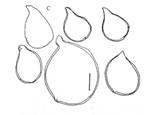 |
Females:
- Body slightly protruding from host root; covered by capsule
formed of old cuticle, collapsed host tissue and fungi.
- White color, spherical to pyriform with short neck
- Lip region with two annules, offset from body by a constriction;
squarish labial disc.
- Cuticle finely striated throughout body, lacking a subcrystaline
layer.
- Stylet about 25 um long, knobs with forward projection
- Excretory pore posterior to median bulb
- Spermatheca oval, with sperm.
- Vulva postequatorial with slightly protruding lips
|
Meloidodera zacanemsis - shape of females: Note postequatorial position
of vulva in larger specimen (bar = 100 um)
Drawings from Cid del Prado V. 1997 |
|
Second-stage
juveniles:
- Body length <500um
- Labial region with 4 annules, offset by a constriction.
- Stylet mrobust with knobs projecting anteriorly
- Phasmid not lens-like.
- Tail conical.
Ref: Cid del Prado V., 1997
|
Males:
- Relatively short, <700 um
- Lip regioon with two annules, separated from body contour by a
constriction; oval labial disk.
- Stylet less robust than in J2
- Lateral fied with 4 incisures
- Spicules slightly arcuate; gubernaculum delicate.
- Tail short, rounded
|
|
Reported median body size for this species (Length mm; width micrometers; weight micrograms) - Click:
|
|
Nurse cell system is a uninucleate giant cell.
Baserd on presence of males and sperm in the female spermatheca, assumed
to be secually reproducing.
Cid del Prado V. 1997. Description of Meloidodera zacanensis sp.n.
(Heteroderidae), a parasite of tejocote trees in Mexico. International Journal
of Nematology 7:165-169.